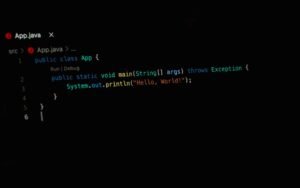No Code Coding
When you think of coding, you may envision long hours hunched over a computer, writing lines of complex code. However, there is a new trend emerging called “no code coding” that challenges this traditional perception. No code coding allows non-technical individuals to build applications and websites without having to write a single line of code. In this article, we will explore what no code coding is, its key advantages and disadvantages, and its potential impact on the future of software development.
Key Takeaways
- No code coding enables non-technical individuals to create applications without writing code.
- Advantages of no code coding include increased speed and efficiency in application development.
- Disadvantages of no code coding include limited customization options and potential reliance on third-party providers.
- No code coding has the potential to democratize software development and bridge the gap between technical and non-technical individuals.
No code coding platforms provide users with visual interfaces and pre-built templates that can be customized to create the desired application. These platforms often utilize drag-and-drop features that allow users to easily add and arrange elements on the interface. *This eliminates the need for traditional coding knowledge, empowering individuals with little to no technical background to design and build their own applications.*
One of the main advantages of no code coding is the reduced development time. Traditional coding can be time-consuming, requiring developers to write and test lines of code. No code coding platforms streamline this process by eliminating the need for coding from scratch and providing ready-to-use components. *Users can simply select pre-built elements and customize them to fit their needs, significantly reducing the time required to develop an application.*
Additionally, no code coding platforms often offer integrations with popular tools and services, allowing users to easily incorporate functionalities such as payment gateways, databases, and analytics. *This integration capability eliminates the need for users to code these functionalities from scratch, further speeding up the development process.*
Despite its advantages, no code coding does have its limitations. One of the main disadvantages is the limited customization options. While no code coding platforms provide pre-built elements, these elements may not always align with the specific requirements of an application. *Users may encounter restrictions when trying to implement custom features or functionalities that are not supported by the platform, limiting their ability to fully customize the application.*
| Traditional Coding | No Code Coding |
|---|---|
| Involves writing lines of complex code. | Does not require coding knowledge. |
| High level of customization. | Limited customization options. |
| Time-consuming development process. | Faster development process. |
Another potential drawback of no code coding is that it often relies on third-party providers. Users depend on the platform’s infrastructure, support, and updates, which introduces an element of risk if the provider goes out of business or discontinues the platform. *This reliance on third-party providers can limit control over the application and its future development.*
Despite these limitations, no code coding has the potential to democratize software development. It allows non-technical individuals to participate in the creation process, bridging the gap between technical and non-technical roles. *No code coding platforms provide an accessible entry point for those interested in software development, enabling more people to bring their ideas to life without requiring extensive technical knowledge.*
The Future of Software Development
- No code coding has the potential to revolutionize the software development industry by empowering non-technical individuals to create applications.
- This trend could disrupt traditional software development processes and create new opportunities for innovation.
- However, it is important to consider the potential risks and limitations associated with relying solely on no code coding platforms.
As technology continues to advance, it is vital for software developers and users alike to stay informed about the latest trends and tools shaping the industry. While no code coding is gaining popularity, it is important to evaluate its suitability for specific projects and consider the potential trade-offs between convenience and customization. *By staying updated on emerging trends like no code coding, individuals can make informed decisions about the best approach to their software development needs.*
| Advantages | Disadvantages |
|---|---|
| Increased speed and efficiency. | Limited customization options. |
| Accessible entry point for non-technical individuals. | Reliance on third-party providers. |
| Democratizes software development. | Potential risk of platform discontinuation. |
In conclusion, no code coding opens up a world of possibilities for individuals without extensive coding knowledge. While it offers advantages such as increased speed and accessibility, it also comes with limitations regarding customization options and reliance on third-party providers. By weighing these pros and cons, individuals can leverage the power of no code coding and potentially contribute to the future of software development.

Common Misconceptions
Non-Technical People Cannot Code
One common misconception about no code coding is that it is only accessible to individuals with technical backgrounds or coding experience. However, this is not true. No code coding platforms have been specifically designed to allow non-technical people to build functional applications without having to write any code.
- No code platforms provide user-friendly interfaces
- Drag and drop functionality enables easy application development
- User-friendly documentation and tutorials are available to guide beginners
No Code Coding is Inferior to Traditional Coding
Another misconception is that no code coding is inferior to traditional coding methods. While it is true that no code coding may have some limitations, it can be a powerful tool for creating a wide range of applications quickly and efficiently.
- No code coding is ideal for prototyping and MVP development
- No code coding allows for rapid application development
- No code coding frees up developer time to focus on more complex tasks
No Code Coding is Not Scalable
Some people mistakenly believe that no code coding is not scalable. However, many no code platforms offer robust scalability options to accommodate growth and handle increasing user demands.
- No code platforms provide scalability options such as cloud hosting and auto-scaling
- No code coding can handle tens of thousands of users and large datasets
- No code platforms often have APIs to integrate with other systems to enhance scalability
No Code Coding is Limited in Functionality
People often assume that no code coding is limited in functionality, but this is not the case. No code platforms offer various tools and functionalities to create sophisticated applications that can fulfill a wide range of requirements.
- No code platforms provide pre-built components and templates for common functionalities
- No code platforms allow for custom code integration when needed
- No code coding supports integrations with external services and databases
No Code Coding is Just Drag and Drop
While drag and drop functionality is a characteristic feature of no code coding, it is not the only aspect. No code platforms offer a combination of visual development tools, data modeling capabilities, and logic-building features to create powerful applications.
- No code platforms enable visual workflows and logic building
- No code coding allows for complex data modeling and manipulation
- No code platforms often provide tools for automation and business rule creation

The Rise of No Code Tools
In recent years, there has been a significant rise in the popularity of no code tools that allow individuals to build websites, apps, and other software without the need for traditional coding skills. These tools provide a range of functionalities and ease of use, enabling people from various backgrounds to create their digital projects. This article examines different aspects of the no code movement and highlights some interesting facts and figures related to its growth.
No Code Development Platforms by Market Share
The following table showcases the top five no code development platforms by market share, providing insights into the competitive landscape of this industry. This data is based on the latest available statistics.
| Platform | Market Share (%) |
|---|---|
| Adalo | 22 |
| Webflow | 19 |
| Appgyver | 16 |
| Bubble | 14 |
| OutSystems | 12 |
No Code Development Market Value
The no code development market has experienced tremendous growth in recent years. The table below provides a glimpse into the market’s financial value, including annual revenues and projected future expansion.
| Year | Market Value (in billions USD) |
|---|---|
| 2018 | 1.5 |
| 2019 | 3.2 |
| 2020 | 5.8 |
| 2021 | 10.4 (projected) |
Percentage of No Code Users by Age Group
No code tools have opened up opportunities for people across all age groups to turn their ideas into reality. The following table showcases the percentage distribution of no code users by age group, highlighting the broad demographic reach of these platforms.
| Age Group | Percentage of Users (%) |
|---|---|
| 18-24 | 30 |
| 25-34 | 35 |
| 35-44 | 18 |
| 45-54 | 10 |
| 55+ | 7 |
Most Popular No Code Projects
Wondering what people are actually building with no code tools? The table below highlights some of the most popular no code projects, showcasing the versatility and creativity of these platforms.
| Project Type | Percentage of Users (%) |
|---|---|
| Website Development | 45 |
| eCommerce Stores | 27 |
| Mobile Apps | 18 |
| Data Dashboards | 8 |
| Internal Tools | 2 |
Potential Savings from No Code Development
One of the significant advantages of no code development is cost savings compared to traditional software development. The following table demonstrates the potential savings that businesses can achieve by opting for no code solutions.
| Project Type | Traditional Development Cost (in USD) | No Code Development Cost (in USD) | Savings (in %) |
|---|---|---|---|
| Website | 20,000 | 5,000 | 75 |
| Mobile App | 50,000 | 10,000 | 80 |
| CRM System | 100,000 | 30,000 | 70 |
No Code Adoption by Industry
While no code tools offer benefits to various sectors, some industries have embraced this approach more than others. The table below presents the adoption rate of no code platforms across different industries.
| Industry | Adoption Rate (%) |
|---|---|
| E-commerce | 80 |
| Healthcare | 65 |
| Education | 48 |
| Finance | 37 |
| Manufacturing | 25 |
No Code Skills in High Demand
As the no code movement gains momentum, certain skills related to these platforms become highly sought after in the job market. The table below highlights some no code skills currently in demand.
| Skill | Job Postings |
|---|---|
| Webflow | 1,200 |
| Adalo | 900 |
| Bubble | 600 |
| OutSystems | 400 |
| Appgyver | 300 |
The Future of No Code
The no code movement shows no signs of slowing down and is poised to transform the way software is developed. With its growing market value, broad user base, and potential cost savings, no code development presents exciting opportunities for individuals and businesses alike. As more innovative tools and platforms emerge, the possibilities for creating digital solutions without coding are seemingly endless.
Frequently Asked Questions
What is no code coding?
How does no code coding work?
Is no code coding suitable for professional software development?
What are some popular no code coding platforms?
Can no code coding be used for complex applications?
What are the advantages of no code coding?
Are there any limitations to no code coding?
Can no code coding replace traditional coding?
Is no code coding more accessible than traditional coding?
Are there any recommended resources to learn about no code coding?





